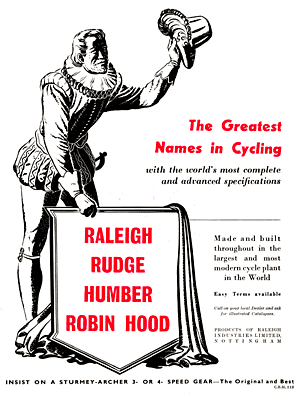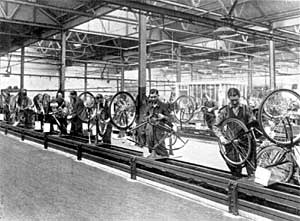
1886-1951

Raleigh has a special place in the history of Nottingham. It not only brought international recognition for its innovatory designs and excellence in production, but also had a major impact on the local economy and community.
Frank Bowden, the founder of Raleigh, was the son and grandson of prominent manufacturers in Nottingham but decided to join the law profession and moved to Hong Kong to advance his career. He accumulated a substantial fortune, but in the 1870s was obliged to return to the United Kingdom due to poor health. After a visit to a doctor in Harrogate he took up cycling to improve his condition and became so enamoured with it he decided to channel his enthusiasm into the nascent cycle industry.
The Raleigh Cycle Company had small beginnings; the ‘Raleigh Safety’ bicycle – with a chain drive to the rear wheel instead of direct drive to the front wheel – was one of a range being produced at a rate of three a week in 1886 by Woodhead, Angois and Ellis at their small premises on Raleigh Street. Bowden believed that there could be an enormous demand for this product and realised its future potential. He recognised that Woodhead and Angois possessed the necessary technical expertise to develop the product and this would allow him to concentrate on the business side of the enterprise. In 1888 after negotiations with the three men they founded the Raleigh Cycle Company. The little workshop on Raleigh Street was quickly disposed of and a five-storey building on Russell Street was acquired. It was soon equipped using Bowden’s money and production rose to 60 machines a week and the workforce to 200. By 1896 Raleigh had outgrown its premises in Russell Street, and a large new factory equipped with the latest machinery opened on Faraday Road, Lenton. The move contributed to the increase in production from about 10,000 cycles a year in 1900 to 60,000 in 1913.
In 1889 the company was floated on the market with Sir John Turney, chairman and managing director of Turney Brothers, Leather Works, Trent Bridge, Nottingham appointed in 1891 to help guide the decision making. The new management team facilitated the development of the business.
By this time the major changes in bicycle manufacture had already been developed but Raleigh was keen to be innovative, and a feature of the early bicycle was an adjustable back axle and anti-vibration device on the front. In 1892 they also pioneered the tubular fork crown which was to become the hallmark of the Raleigh cycle. The ‘Raleigh Safety’ cycle (one of a number of the new-style bicycles being manufactured at the time) standardised the frame and shape into the modern form that is still in use today. This, together with the incorporation of the Sturmey-Archer three-speed gear hub in the early 1900s and the potential use of the pneumatic tyre patented by John Boyd Dunlop, helped assure Raleigh’s future. A later study of cycle production methods in America resulted in the ‘All-Steel’ bicycle being developed using sheet steel for the frames and the dip-brazing method to join the frames. In order to stay one step ahead of his rivals Bowden made sure that all the bicycles produced by the company were of good quality and introduced a far reaching promise, “The Raleigh Everlasting Guarantee”. He was also a very astute businessman and introduced a system whereby customers could purchase cycles via a company also owned by Raleigh known as Gradual Payments.
The company began to bring out a wide range of models and realised that the increasing demand for Raleigh cycles was enhanced by the success in cycle racing which had become a sporting attraction. This in turn led to the company sponsoring A A ‘Zimmy’ Zimmerman, a famous American amateur racer.
Raleigh attempted to diversify production in response to a slump in the cycle market at the turn of the twentieth century. Much development work was done in 1904 on the Raleighette (three-wheeled motorised vehicle) and simultaneously on motorcycles, but by the end of the year production on motorcycles was abandoned, and no more development was done until after the First World War. Production of the Raleighette continued until at least 1908, but did not prove to be popular.
When the news broke that Britain was at war with Germany in 1914 Raleigh sales received a huge boost. Not only did the Government buy special new ‘war’ models but the public returned to the bicycle as the favoured (and more economical) form of transport. Cycle production continued during the First World War but at a greatly reduced level since a large part of the factory was quickly turned over to munitions, primarily due to the foresight of Frank Bowden, recognising the production needed for the war effort. By the end of the conflict the Raleigh factory had been transformed. It now employed a workforce of nearly 5,000, many of them women, who worked shifts around the clock, whilst the factory had been considerably enlarged and equipped with a vast amount of new and sophisticated machinery.
A new factory extension was opened in 1922, followed in 1931 by Raleigh’s new office block on Lenton Boulevard, designed by Cecil Howitt. The plans included a theatre, ballroom, dining room, rest rooms and a show room.
Between the wars Raleigh continued to grow and by 1936 was producing half a million cycles a year. Between 1920 and 1930 the company re-introduced its motorcycles but with no great success. The company bought out other cycle producers including Humber in 1932 (originally made in Beeston but had moved to Coventry) and also Hercules cycles. Depots were set up in other towns including Manchester, Bristol, Dublin, Belfast, Liverpool, Aberdeen, Birmingham, Leicester, Derby and Sheffield.
Munitions production started again in 1936 and with the declaration of war in September 1939, production was immediately dropped to only 5 per cent of normal output, with work focused on the manufacture of fuses. The factory site was camouflaged and an extensive Air Raid Precaution training scheme was set up.

Raleigh bicycles being assembled on the conveyer line (c. 1950)
Post-war production rose rapidly, surpassing the one million mark in 1951 and since the existing works were too small to handle the magnitude of output, it was decided to build a new factory. This was opened in November 1951 by the Duke of Edinburgh. It cost £1 ¼ million and brought the size of the Nottingham plant to 40 acres (from Faraday Road westwards). But this was still not enough. Raleigh had taken over their rivals Rudge Whitworth in 1943 and Triumph and Three Spires in 1954. A vast extension costing £5 million was opened by Field Marshall Lord Montgomery in 1957 and increased the size of the site to 60 acres. However, the opening coincided with a slump, particularly in the export market, and the additional factory remained unequipped and unused for a time. The cycle was abandoned in favour of the car and sales in the UK halved. Raleigh’s dominance was also threatened by the rival conglomerate, the British Cycle Corporation, and to avoid damaging competition Raleigh sold out to Tube Investments (TI). Sales slowly began to recover, albeit within a shrinking market.
By 1960, Raleigh had acquired Carlton, a specialist hand-built racing cycle company based in Worksop. They also developed a totally new concept of cycle invented by Alex Moulton. The smaller wheeled machines were marketed first as the RSW range, and later, in the 1960s as the Twenty, and continued production for sixteen years.
1970-2002
In the late 1960s cycle production in America was very much focused on cycles for adolescents and Raleigh tried to enter the American market with the Raleigh Chopper but they were too late. However with its launch in the UK, the Chopper began a new era of bicycle production. It was aimed directly at the teenage market and proved to be an instant success; other fashionable bikes followed including the Grifter and later the BMX. In 1985 Raleigh launched a series of Mountain bikes; the first being the Maverick but it was to be another couple of years before the style caught on with the cycling public. In the meantime a hybrid named the Pioneer was built and launched in 1991 becoming a popular saleable cycle.
Despite the downturn in sales in the UK, Raleigh cycles have and still do have a considerable reputation around the world, especially in countries where economical transport is a priority, for example in Africa where the old fashioned 28-inch wheel roadster is very popular.
Changes in the cycle industry, in particular the move from manufacturing to assembling, ensured a different landscape in Lenton. The 1957 factories were demolished in 1996 and Raleigh sold part of the site (now the Jubilee campus) to the University of Nottingham in 1997. Finally in 2002 Raleigh left the city altogether for new premises in Eastwood, concentrating purely on assembly as manufacturing was now undertaken in the Far East.
Cycle racing
From as early as 1892 Raleigh had led the world in cycle sports success; foremost among the riders being the American world champion A A ’Zimmy’ Zimmerman. By the early twentieth century attempts were being made on various cycling records, particularly on long distance races. In July 1908 Harry Green rode the 837 ½ miles from Lands End to John O’Groats in a spectacular two days, nineteen hours and fifty minutes on his Raleigh cycle. This record remained unbroken until 1929 when Jack Rossiter completed the journey, shaving six hours and twenty eight minutes from the time set by Green. However it was still a Raleigh success as Rossiter had used the same make of cycle as Green and the same three-speed gears.
The name of Reg Harris dominated cycle racing in the early 1950s. Reg signed as a professional with the company in 1949 and in that year became the first ever Englishman to win the World Professional Sprint Championship. He won again in 1950, 1951 and 1954 gaining victory on his famous ‘Red Raleigh’. He used it again when he spectacularly came out of retirement in 1974 to win the British Professional Sprint Championship at Leicester. In the late 1960s Raleigh formed a professional cycling team with some success. In 1972 the team was renamed TI Raleigh and was divided into a European road racing team and a British team. The teams enjoyed great success, including team wins in the Tour de France in 1977 and 1983. However, lack of television coverage and public apathy led to the eventual dropping of the road racing team. In 1989, with a growing interest in mountain biking, the Raleigh MTB team was launched and continues today.
An online exhibition, ‘Wheels of Fortune’ featuring documents from the Raleigh Cycle archive is available on the Nottinghamshire Archives website at www.nottinghamshire.gov.uk/wheelsoffortune.
See also the Nottinghamshire Archives book, Turning back the pages of ... Raleigh Cycles of Nottingham.